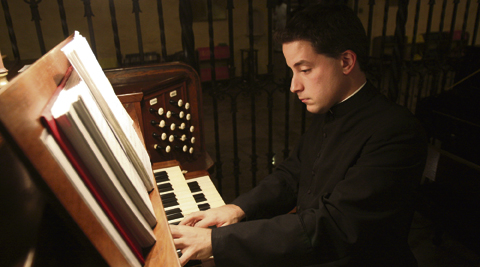February 21 | ![]() 0 COMMENTS
0 COMMENTS ![]() print
print

Master of one ‘trade,’ jack of many
A working knowledge and appreciation of both architecture and music would seem helpful to seminarians and priests, according to Cath Doherty
Reflecting on Pope Francis’ recent comments on the qualities required of spiritual leaders, and a suggestion that greater scrutiny should be applied to those who present themselves as candidates for seminary training, brought me to recalling something Pope Emeritus Benedict. He suggested that seminary training should include something both of architecture and of music, given that, as priests, seminarians would be called upon to make decision in both areas. And as parish priests, these decisions would be protected by Canon Law.
At one end of the scale, needless delays and endless argument would be avoided. At the other end comes the risk that a church, such as a Pugin church, might lose its architectural integrity. And as Plainsong makes a tentative return, so do renewed arguments about the exact nature of church music, the standard to which we should aspire. A working knowledge of both architecture and music would seem helpful to seminarians who have no previous experience of either area. And in a place where architecture and music meet comes something that would be a treasure for any church… the pipe organ. From a whisper that bids spiritual reflection to a shout of triumph that sends the congregation out singing God’s praise’s, they inspire those who listen to them. Their appearance is pleasing to the eye, graces any church.
No two pipe organs are exactly the same. Each one has its own provenance. From the magnificence of the great instrument in the church of St Sulpice near Paris, a pipe organ which, is claimed, is the largest in Europe, to the small pipe organ in a country church, each instrument has its own particular identity. Irrespective of their size, they are fragile creatures, in that neglect can kill them.
Two things that pose a serious threat to church organs are detritus from repair work carried out near them, such as dust and excessive heat. They carry no specific price but all of them are very valuable.
Their history here in Scotland is fascinating, after the turmoil of Penal times, when Bishop Hay founded the seminary at Aquahorites, the boys there had more space, more amenities than at Scalan. Among them was a workshop, where they could learn organ building as a skill. There followed an unexpected famine in Church music, when Bishop Hay, himself an accomplished violinist who encouraged seminarians to learn to play musical instruments, banned music in Catholic churches or indeed any places of worship. The ban covered everything, from the playing of organs or other musical instruments to singing. Bishop Hay did not give explanations for this, but, in a way, it can be understood.
There had been widespread destruction of Catholic places of worship for some two centuries after the Reformation. In 1746, this seemed to have become commonplace yet again. In 1779, Bishop Hay had a narrow escape when his house and church were looted and burned to the ground by a mob in Edinburgh. His refusal to allow the emergence of Church music was most likely part of a strategy to move slowly forward from the extremes of Penal times and not to attract unwelcome attention. Some priests used the skills acquired in seminary and built organs or other musical instruments while they waited. There was just a hint of priestly disobedience in Edinburgh, when Fr Menzies, chaplain to the highland congregation there, had Adeste Fideles sung one Christmas…
When Bishop Hay, his health failing, went to spend his last years back at Aquahorties, his place was taken by Bishop Cameron. Fr Charles Gordon of Aberdeen was allowed to install a pipe organ in his new church. There, High Mass was sung at last… the only place in Scotland where this took place before 1814. The trickle of music became a torrent as pipe organs were installed. Records of the time show that subscriptions were gathered in Edinburgh in 1817, this for the installation of pipe organs in the churches there, and by 1820 most of them had their musical instruments. Firms of organ builders seemed to be doing a roaring trade. Among the records of that time are letters telling of wealthy Presbyterians being attracted to churches in Glasgow by the music there, and of certain pipes organs of quality resultantly becoming ‘money makers’ for their churches.
Choirmasters were appointed, choirs trained. Organists were trained too. One record tells of a musical priest, a Fr Gordon, who had trained six organists for other parishes by 1819. He was very businesslike about this, requiring triness to live in the house of his organist for the duration of their training at a cost of five shillins a week. Fr Gordon took a fee of 10 guineas for training, plus five shillings for ever sheet of musical theory prepared for the pupil. The records of this time tell, too, of a Fr Mathieson who was putting the finishing touches to the organ he had built for his own church, but had made a double bass to accompany the singing until the organ had been properly tuned. In the 19th century, Catholics took the lead in the provision of pipe organs. Concerts of scared music and oratoria were held in Catholic churches borrowed for the purposes simply because their Presbyterian neighbours did not have organs in their churches. It is satisfying to know that music was, in a way, a peacemaker after centuries of discord.
Pipe organs in use today have highly individual organs. Some have a provenance that can be traced back to century of which I have written. Materials for others have been recovered from redundant churches, stored, then rebuilt with additional components by skilled organ builders. There is no set priced, no brand-name model as with electric instruments. There are, in a way, ‘made to order.’ But they need careful maintenance. And to go back to the beginning of this piece, this is one area where Pope Emeritus Benedict’s word on studies for seminarians has a particular relevance.
I have been a church organist for most of my life. Now and then, I’ve been asked to ‘fill in’ here and there… Over the piece, I have played a large number of church organs. Some, though of fleeting acquaintance, stick my memory… like the ancient harmonium with one of the two foot bellows collapsed, which required frantic pedalling with one foot to get enough air into it. At the end of it all, I felt as if I had run a marathon…
Another suffered spontaneous combustion during Confirmation. And then there was a sort of large keyboard where one false move on my part would have resulted in a blast of some Latin American rhythm… Now, I enjoy the privilege of playing a very fine pipe organ, gifted to our church more than two decades ago. We’ve been together for all that time. A few weeks ago, it gave a little whine of discomforts as Mass was about to begin.
“Behave yourself,” I whispered. And it did. Eccentric behaviour? No. It simply illustrates the fact that these instruments are so special, so highly individual that they become acquaintances, and indeed friends to those who play them for a long time.
*** This version of Cath’ Doherty’s Feb 14 comment article is online due the administrative errors in the print edition version of her SCO column for which the writer apologies










